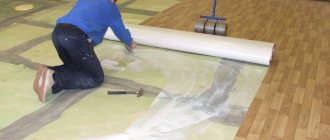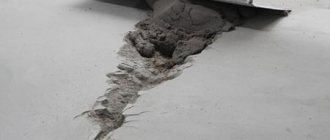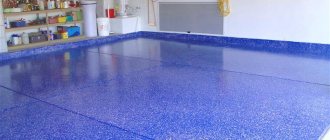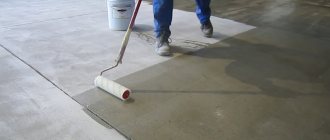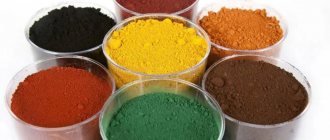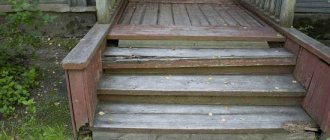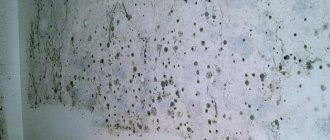Concrete floors have many advantages and only one drawback - insufficient surface strength, which wears out during use. Concrete floor topping strengthens the top layer of concrete, increases its strength and extends its service life. When laying the mortar, the dry reinforcing mixture is applied to a wet concrete slab, grouted with a grouting machine and covered with a layer of membrane former. The main feature of this type of flooring is that it does not require additional protection on top of the hardener.
What is a heavy-duty concrete foundation?
Conditions, timing of concreting and operation of the base affect the methods of concrete hardening:
- Topping. The application of dry mixtures and their further grouting is carried out on freshly laid screeds.
- A liquid type of impregnation (lithium hardener) is used for finished, recently laid or old floors.
Topping (hardener) consists of a special mixture of fixing agents for application to the top layer of concrete mortar for the purpose of strengthening; its thickness is generally several millimeters. Topped concrete floors are made from high quality cement, solid and liquid components and pigments. With the application of the mixture, strength increases by 3 times, and wear resistance by 4.
The floor surface with topping brings lower grades to match M600-M800.
A rotary trowel will help to rub the composition into the concrete, after which impregnation is applied.
The composition is rubbed into the concrete using a rotary trowel. A special impregnation (sealer) is applied as the final stage after grouting the dry mixture. Its composition can be both organic and mineral. The fixer hardens due to the water component in the concrete. The pores on the surface of the concrete are closed, making the base dust-free. Characteristics of a concrete floor using topping:
- frost-resistant;
- waterproof;
- high-strength (service life 7-10 years at maximum load);
- dust-free;
- high adhesion;
- shockproof;
- chemically inert;
- sparklessness;
- reduced abrasion (0.2-0.5 g/cm2);
- resistant to petroleum products;
- environmentally friendly and hygienic.
Composition and properties of dry topping
The optimal mixture is obtained by mixing the main components:
- plasticizers to increase plasticity and water resistance;
- cement;
- fixatives with pigments.
The sealer is used as a waterproofing layer to prevent cracking and drying out of the mixture.
The properties of a plasticizer for concrete is to accelerate the development of strength not only at the pouring stage, but also the finished surface.
Sealers on flooring with toppings are used as moisture-retaining impregnation. This will prevent the concrete composition from drying out and cracking. No further maintenance is required for concrete after application.
What is topping?
Topping is a modern strengthening mixture. It is always applied to the top surface of the concrete. The composition of the material is varied and can contain from 6 to 8 components . Blade machines are used to apply the dry mixture.
Hardening of the hardener is realized due to the water contained in it
After spreading and grouting, a special impregnation (sealer) is applied. Such compositions are often called liquid or chemical toppings, but this is not entirely true.
The main technical and practical characteristics of dry mixtures are as follows:
- abrasion resistance - by looking at this indicator, you can find out how quickly the topping will come off the surface during use. Unit of measurement – g/cm². The lower the indicator, the more wear-resistant the surface will be;
- compressive strength - this indicator indicates what maximum pressure the finished surface will withstand. The unit of measurement is MPa. The higher the indicator, the more pressure the floor can easily withstand;
- the likelihood of detachment is a question based on practical experience. With optimal strength and durability, the topping can peel off in one go. This can happen due to low-quality raw materials or violation of work technology. So it’s better to check the availability of certificates and turn to professionals;
- ease of use - no matter how great the topping is, it must be properly rubbed in. In practice, the lack of high-quality grout deprives the hardener of all declared indicators;
- marking - the material must be marked with the batch number and production date. If there is none, it is better to turn to other analogues;
- date of manufacture - the best hardener is the freshest hardener possible. As you know, cement loses its properties during storage, plus it is not known where and how the mixture was stored, so it is better to play it safe;
- humidity is a good hardener, ideally dry. Lumps in packaging are simply unacceptable. This suggests that the hydration process has already begun inside. This composition is very difficult to apply and rub in;
- fraction - if the aggregate size in the material is increased, the production cycle is disrupted. It is likely that other technological flaws are not excluded. Before grouting, it is better to definitely consider the composition for this item.
Laying process and characteristics
A concrete hardener rubbed into the surface greatly enhances its strength and improves the characteristics of the base, but without changing its initial properties. But such a floor is unsuitable for use if it is affected by acids and alkalis in the chemical industry. Treatment of the top layer increases wear resistance to 0.22 g/cm² (9th wear resistance class), and the hardness of concrete on the Mohs scale to 6. The strength of concrete at the time of full force is transferred to it is observed after 28 days, when the concrete has completely hardened.
Steps for doing your own topping:
- Preparing the base.
- Pouring concrete mixture.
- Applying topping for concrete.
- Grout.
- Treatment with strengthening dust-removing impregnation or membrane former.
- Cutting and filling seams.
Areas of use of topping floor
This technology for strengthening concrete bases is used in warehouses, industrial and production workshops. Due to their hygiene, such floors are indispensable in the food industry. Due to their frost resistance, topped concrete floors are the best solution for refrigerators and freezers. The presence of reflective qualities ensures the demand for the hardener on objects with elevated temperatures.
High wear-resistant qualities make the protective coating indispensable in places with increased vibration and mechanical load, such as parking lots, shopping and entertainment complexes, medical, cultural and educational institutions, and pedestrian areas with high traffic. This industrial floor screed is widely used in car dealerships, car service centers, hangars, garages, where the top concrete coating is constantly in contact with gasoline and diesel fuel, slightly alkaline liquids and mineral oils.
Important! Topping cannot be used for rooms where acids and alkalis are widely used, for which special impregnations are acceptable.
Topping floors, due to their hygiene, are indispensable in dining rooms
Topping helps to increase the service life of floors in gyms, sports fields and swimming pools. The coating today is widely used on civil objects, which is associated with low maintenance, durability and decorativeness of the surface when using colored compounds.
Topping for concrete floors: types of hardeners
There are three types of concrete hardeners: quartz, corundum and metallized. The first option is the most popular and in demand. It also has the most affordable price. The main filler of the mixture is perlite, which can be combined with coloring pigments. This feature has a positive effect on the technical and operational characteristics of the surface, changing its appearance.
Quartz topping is the best option for bases that experience medium-intensity loads, which is typical for warehouses, entertainment and shopping centers, and educational institutions. Such reinforcements are also widely used in the construction of residential buildings.
Important! Quartz topping helps to increase the strength properties of concrete by 1.5 times.
Corundum filler is selected for objects in which the floor experiences severe loads
In corundum toppings, the filler is corundum chips. This mineral additive has high strength characteristics, increased wear resistance and abrasion resistance. The hardener helps to increase the strength of concrete by 2 times.
Related article:
Laying laminate flooring on a concrete floor with underlay: complete coating installation technology
Detailed description of preparatory work, technology features. Installation of underfloor heating system under laminate flooring.
Corundum toppings are used at facilities where large and heavy equipment is installed, as well as in places with heavy traffic of people and vehicles. This situation is typical for warehouse-type premises, gyms, facilities and special-purpose sites.
Important! Corundum topping gives the finishing surface a pleasant matte finish.
The main filler of metallized toppings, the price of which is the highest among analogues, is metal shavings. Such mixtures contain concrete mortar. Thanks to its components, metallized topping is considered the most reliable floor strengthener, which increases its strength by 2.5 times.
Metal topping is expensive but very effective
This topping is used for objects experiencing excessive loads, where massive equipment is installed, heavy machinery is moved daily, and is characterized by increased vibration.
When constructing residential buildings, it is not advisable to use such a composition due to its high cost and rather complex application technology.
Varieties
Corundum topping is used for surfaces that are subject to heavy operational load.
Toppings used to strengthen concrete floors are of 3 types:
- Based on quartz. Used for floors with medium mechanical load.
- With the addition of corundum. Recommended for use on substrates subject to heavy operational loads.
- Metallized. This type is suitable for fairly heavily loaded concrete floors.
Toppings with added corundum
This type is used for slightly increased floor loads. These are places where factory workers or small vehicles frequently pass indoors, where abrasion occurs. Corundum hardeners contain, in addition to sand, crushed clinker powder and plasticizing additives, corundum chips. This component prevents their rapid destruction and adds shine. Experts say that corundum hardeners for concrete floors are often 20% more expensive than those with the addition of quartz.
Quartz hardener
It is the low cost that ensures its high popularity. Its main area of application is covering concrete floors in warehouses, shops, parking lots and workshops. Quartz-based topping can withstand average operating loads. For color variations and increased aesthetics, a coloring pigment is used.
Properties of metallized topping
It contains metal shavings and concrete mortar, which ensures the preservation of performance at a given design level and its strength. This type of topping is used on a set of production means necessary to carry out the production process, for example, for the installation of heavy machines and related equipment, the passage of special technical machines weighing several tons. It is not used in households. It provides strengthening of the upper thin layer of concrete, eliminating residual deformations under the influence of loads.
It is worth noting that the increase in compressive strength and wear resistance of concrete occurs exclusively in the top layer, which is 3 mm thick; in the remaining parts of the capillary-porous body of concrete, the properties and characteristics will correspond to the class poured into the pouring strip.
The cement screed creates a solid foundation that can withstand pressure. All other types of external influences - friction, water, chemicals, oils and motor fluids - gradually destroy the top layer. When liquid is constantly injected, it penetrates deep into the surface, causing peeling of large areas, mold and an unpleasant odor in the air. Liquid topping for concrete reliably protects the surface, making it more durable. Strengthening the surface of freshly laid (new) concrete floors using “cast” technology, as well as for installing a thin-layer high-strength coating of existing (old) concrete floors indoors and outdoors, experiencing moderate abrasive and moderate impact loads. Coating thickness over existing concrete base from 7 to 15 mm.
Liquid topping: what is it ?
The new adaptive hardening technology developed in the company’s laboratories allows you to create a uniform coating of uniform thickness, characterized by its durability, and also virtually eliminate the “cobweb” effect that is so often found on reinforced concrete floors.
Unlike traditional powder toppings, the composition is mixed with water before application to the base and, in a liquid state, is laid on fresh concrete. While the adaptive technology is generally similar to the traditional one, the fundamental difference in the method of applying the reinforcing layer makes it possible to clearly control the uniform distribution and concentration of the cast topping over the entire area, which increases the durability of the coating.
Externally, the material is similar to bulk polymer, which is used to create a protective decorative coating. This is where the similarities end - the application method and the method of adhesion to concrete are different. A floor reinforced with MasterTop 135 PG is 2–3 times more wear-resistant than heavy concrete class B25. This ensures a high degree of dust-free coating and increases the service life of the floor. - Provides repair, leveling and strengthening of worn (old) concrete floors, when it is impossible to significantly increase the “finishing” level of the floor. - The floor surface treated with MasterTop 135 PG material, becomes very dense, which increases the impermeability of concrete to water and aggressive substances, qualitatively improving frost resistance and resistance to oils and other fuels and lubricants. - The strengthened layer is homogeneous with the concrete base. - The mixture can be supplied using a mortar pump without delamination. - The material is available in various colors, resistant to UV radiation. The coating does not fade during use.
Liquid topping in its pure form forms a coating that can withstand foot traffic well. It is absorbed into the top layer of concrete, filling its pores and forming a gel-like substance. It completely hardens, turning into one with the cement screed - a surface is formed that is resistant to mechanical stress and getting wet.
Restrictions
- Floors where operating conditions require the use of a more wear-resistant or more impact-resistant coating.
- Floors exposed to acids, salts or other substances that have an aggressive effect on concrete.
- Floors with high requirements for decorativeness and hygiene.
Application technology
The advantage of liquid topping is its versatility - it is suitable for old dry surfaces and new, freshly laid ones. If the new cement screed does not need preparation, then the old one must be checked for damage:
- identify unstable areas that peel off using the tapping method;
- a visual inspection will help you understand where there are cracks, chips and potholes;
- places of delamination must be cleaned of cement, which is crumbling, and filled with cement-sand mortar with preliminary priming of the surface of the pit;
- Fill small depressions with putty;
- After drying, sand and remove dust.
Filling work is carried out at a temperature of +5 degrees, but not higher than +35. If the screed is fresh, installation is possible a week after its installation, when it has gained strength sufficient for rough grinding. After grinding the following steps are performed:
- liquid topping is applied in three ways - spray, roller or pouring from a container (depending on the area of the room);
- if the material is quickly and completely absorbed, re-filling is performed;
- after an hour it is moisturized - for deeper penetration;
- the thickness of the topping should be two to three millimeters;
- After a day, complete polymerization takes place - excess is removed by washing.
If application is carried out on a wet screed, it can be used within a month. Old concrete is ready for use within a day. Order topping industrial floors at affordable prices.
Facebook Comments
Similar news
- Warming up concrete in winter Warming up concrete in winter Everyone knows that concreting is mainly carried out in the summer, since...
- We are concreting a platform for a car We are concreting a platform for a car You cannot do without a concrete platform for a car if you live in…
- The quality of concrete is going down The quality of concrete is going down In Voronezh, low-quality concrete is increasingly appearing on the market. First on…
Leading manufacturers
The dry type of Alfapol Corundum mixture is used for freshly laid concrete screed.
A hardener for treating a concrete floor is selected depending on its type, application and manufacturer. Russian-made toppings are almost always in warehouses; if necessary, the required volumes of products can be delivered or made within a few days, if this concerns the main shades, and for colored shades – up to 2 weeks. For freshly laid concrete screeds, use a dry type of topping (“Alfapol Corundum” or “Mastertop”). To enhance the hydrophobic properties - compositions of complex additives (Kalmatron, Etalon, Interhard). The most famous brands and products on the market:
- “Protexil” LLC “NPO KRASKO” is a deep penetration dust-removing impregnation made on an organic basis.
- "Interhard" LLC "InterAqua" - liquid lithium hardener.
- Alliance LLC SuperTop, Sealer, LiTec - topping, sealer and lithium impregnation.
- "Elakor-PU" Siler is a water-retaining impregnation for concrete.
- "Di-Trade" Durocem - concrete care.
Scope of application of the hardener
View “SNiP 2.03.13-88” or
The installation of concrete floors and coverings is regulated by SNiP 2.03.13-88. Experts do not recommend using the strengthening mixture in areas where there is active use of aggressive chemicals. The scope of application of reinforced concrete industrial floors is as follows:
In most cases, reinforced flooring is used in the construction of parking lots or parking lots.
- Warehouses.
- Precision mechanics and electronics enterprises.
- Industrial premises with high operating loads.
- Parking lots, garage complexes, parking lots.
- Medical institutions.
- Loading and unloading areas.
Final word
Concrete industrial floors and hardened surface technologies are designed to improve the quality of the surface of fresh mortar with dry mixtures, which are rubbed in using a self-propelled road machine designed for the installation of cement concrete pavement. Strengthening mixtures provide a monolithic coating of the concrete floor, the absence of defects and delaminations, preventing dust formation, greatly increasing its resistance to impacts (impact and wear resistance) without changing the timing of the work.
Floors with a hardened layer
In order for a concrete floor to successfully withstand mechanical loads, topping is added to the freshly poured mortar (five to six hours after leveling, and the cement must be at least grade three hundred and not have any additives), which results in a hardened coating. It is important that the preparation of the base (preparation of mortar, reinforcement, thickness) fully complies with SNiP and the previously drawn up project.
Toppings
The topping itself consists of the following components:
- plasticizers;
- high quality cement;
- fillers with dyes that provide resistance to mechanical damage and various colors.
Important information! Consumption depends on the planned load on the floor, although on average it varies between 3 and 9 kg/m².
Corundum topping Solidtop
The advantages of dust-free industrial floors include:
- high strength;
- ease of care;
- wear resistance;
- hygiene;
- affordable price (approximately 1.6 thousand rubles per 1 m² with a height of 8 cm);
- almost complete absence of dust;
- high installation speed;
- durability;
- heat resistance.
But there are also disadvantages, including:
- presence of seams;
- low resistance to chemicals;
- low maintainability.
| Specifications | Quartz | Corrund | Metal |
| Layer thickness | 2-3 mm | 2-3 mm | 2-3 mm |
| Strengthening period | 28 days | 28 days | 28 days |
| Pedestrian load | After 1 day | After 1 day | After 1 day |
| Light load (no more than 200 kg/cm2) | After 7 days | After 7 days | After 7 days |
| Compressive strength after 28 days of curing | not less than 80 MPa | not less than 85 MPa | not less than 90 MPa |
| Tensile bending strength after 28 days of curing | not less than 7 MPa | not less than 7 MPa | not less than 8.1 MPa |
| Maximum shrinkage | 0,09% | 0,09% | 0,09% |
| Bulk density of the mixture | 1846 kg/m3 | 1970 kg/m3 | 1920 kg/m3 |
| Maximum particle size of dry mixture | 3.2 mm | 3.2 mm | 3.2 mm |
| Abrasion on disk LKI-3M | 0.11 g/cm2 | 0.14 g/cm2 | 0.11 g/cm2 |
| Impact resistance | 20 kg/mm2 | 20 kg/mm2 | 20 kg/mm2 |


